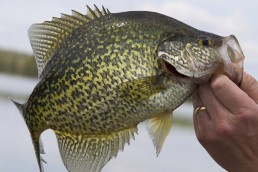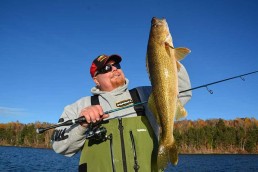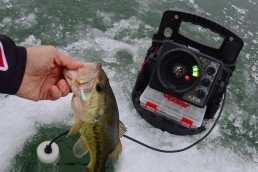Ice Fishing Innovations-New Ice Fishing Tackle & Techniques
SHARE THIS POST
Ice anglers are a pretty inventive group.
In recent years, there have been significant, if not altogether revolutionary ice equipment introductions, among them some truly extraordinary developments in electronics and ice drills. Not to mention the energy sources used to power the; a bevy of spacious, yet lightweight ice shelter designs; and numerous advances in cold-weather clothing.
Countless gear innovations have appeared, including compelling developments in tip-ups, tip-downs, rods and reels, unique spins on a variety of specialized ice tackle accessories—like rod holders, spring bobbers, floats and lines. Plus creative developments in altogether new ice lure designs, along with notable refinements in the progression of existing ones—each skillfully modified to make us more efficient and effective in a variety of situations.
Yet one of the most remarkable highlights might be the increasingly refined rigging and presentation wrinkles being developed—subtle advances leading to quantum leaps in productivity.
Fishing deep water, but finding fish relatively inactive, results in the need for a small presentation to trigger strikes. A heavy-bodied but small-profile tungsten jig might be just the ticket. Too deep for this to be the right solution? How about tying a short dropper line off the base of a relatively fast-sinking spoon?
Are you fishing deep water with current? That’s a good drop-shot rig application.
Hi-vis/vibration ice fishing lures
Low-light or dark-water conditions? Try positioning two metal beads between two micro shot. When jigged, the beads create a subtle and highly effective fish-attracting click or rattle. And you can always add additional beads to vary the commotion, and experiment with color or phosphorescence to improve sight recognition.
Switch things up even more by positioning a clevis teamed with a Colorado, Indiana, willow, prop or smile-style blade between those beads to experiment with a tantalizing range of sound, vibration and flash. Colorado styles add significant vibration—ideal for dark conditions. Willows bring flash in clearer water; Indiana styles furnish a nice blend of each. All add unique nuances to the motion and fall rate of your presentation; simply adjust the style, size and color based on the situation.
Need something more to help trigger strikes? Substitute various colored, faceted beads. Plated gold, copper or silver blades may also help, as may holographic, brightly colored or phosphorescent ones that add an intriguing splash of color. To really stir things up, try two or more flash-generating, iridescent, hammered-finished willow blades—an especially effective tactic when fish are chasing minnows!
Ice fishing jigging methods: Subtle attraction
A more subtle, yet highly productive low-light trick involves placing a faceted glow bead just above a baited phosphorescent jig to generate flashes of fractioned light to help draw fish in. Once there, the nearby scent of live bait tempts reactionary strikes, followed by a texture and taste that causes them to hold on, providing increased opportunity for you set the hook.
For an added twist, try placing a small hole washer between two split shot a few inches above such a set. The added weight helps get even the tiniest presentation down, yet the flattened, horizontal orientation helps offset that weight by moderating the fall of your presentation—and all while heightening visibility on sonar. Painting or adhering a snip of prism or holographic tape to one or both sides of that washer adds effect, too.
Merging combinations of beads, blades and/or the washer idea provides ample material for further experimentation. Simply downsize when working panfish; upsize when seeking larger game fish.
Double trouble
Occasionally you’ll stumble upon a new idea that not only matches a specific situation, but that performs under various conditions…even dramatically different ones. Given an active, competitive school or tight pod of tough-to-tease fish, for instance—seemingly polar opposite situations—tandem rigs offer an undeniably versatile and underutilized resource.
Keep in mind use of multi-hook rigs is restricted or even unlawful in some areas and situations, so be sure to local check local regulations before lowering any such rigs below the ice. But where permitted, tandems often account for improved catches of bluegills, perch, crappies, white bass, stocked trout, whitefish and walleyes.
Are you enjoying this post?
You can be among the first to get the latest info on where to go, what to use and how to use it!
A good example is a simple rig many Green Bay, Wisconsin whitefish ice fishing anglers employ: A small, waxworm gracing a #14 treble hook is placed just above a small barrel swivel linking their main line and a leader extending to a small waxworm-tipped spoon. A surprising percentage of fish are caught on that sliding treble!
A variation of this is the donkey style rig, which simply adds a short leader to that upper, sliding hook. Thus, these rigs consist of two leaders—one directed down off the main line, along with a secondary, upper slip line. Both feature a small barrel swivel on one end, and usually terminate with a well-sharpened hook graced with a favorite, horizontally oriented plastic body on the other.
This constitutes a highly effective winter presentation, especially when jigging tightly schooled pods of bluegills, perch, white bass, ciscoes or whitefish. Modifications to increase versatility are many; including the addition of beads or small flash blades to either line for enhanced attraction, split shot to the main line to help weight the rig down, or placement of a slip bobber stop just below the upper line swivel to permit convenient depth adjustment of the stacked line. Double hook-ups with such rigs are not unusual; when the first fish hits, just set the hook, then pause. A second fish will often chase and strike the trailing bait!
Get the drop on ‘em
Drop-shot rigs are another versatile option—not just for panfish, but larger game fish as well. Just rig a drop-shot hook or two on your main line before adding a drop-shot sinker a specified distance below; then slip a soft plastic tail or favorite live bait onto each hook, and then lower the weight to bottom. You’ll now be able to achieve fully controlled, precision positioning of both baits spaced at the apportioned distances and heights off bottom.
Such rigs can also be modified by substituting a bait-tipped jig in place of the drop-shot sinker. This system allows you to fish bottom and a precise depth (or by using two hooks, depths) above. The jig provides the weight necessary to pull your suspended hook(s) into the desired position, and hold your bait(s) there, while you impart the desired amount of motion to the base jig. This in turn imparts somewhat lesser, but unique movements to the baited hook(s) suspended above on the semi-slack, secondary line(s).
Note a standard tied drop-shot hook or barrel swivel provides a solid, non-slip hook-setting base for the upper line(s) when working larger presentations; slip bobber stops may also be used when fishing panfish, to allow for depth adjustment of the drop hook(s).
Depending what you’re fishing for, you can diversify such presentations by mixing up your tippers: For bluegills, maybe try a small spike or plastic grub on the upper hook, and a larger wax worm on the jig; for crappies, a small fathead or shiner on the hook(s) above, and a plastic tube body on the jig; for walleyes, a mid-sized shiner or chub on the hook, and a short paddle tail swimbait on the jig below. And you can always add contrasting designs, sizes and colors.
Dress things up
Not enough unique ideas?
How about taking a short length of marabou, bucktail, yarn, frazzled braided Dacron line, thread (or a mix of each), and soaking them in fish scent before adorning the entire concoction as a dressing on a plain hook, jig or favorite lure? Or take this concept a step further by adding a small piece of colored sponge, soaking it in your favorite fish scent, and then incorporating that as part of your rig, or even as a nifty lure dressing; this adds a beneficial mix of scent, texture and taste, while helping modify the fall rate of your presentation as well.
You might also wish to consider pinching or tying a trailer of various colored mylar stripping around a split shot or hook shank to add a light-scattering sparkle. Similarly, consider how a short length of aluminum foil, colored wire or pipe cleaner wrapped around a hook shank will provide some unique looks when adorned within your presentation, too.
Trying one of these unique conceptions, alone or in combination with others, is often just what it takes to be different and make things happen. Commit to exploring and experimenting. Don’t hesitate to customize. Think out of the box, and don’t make the mistake of ignoring what might seem like even the most improbable passing thoughts. It’s exactly those kinds of modifications that open new doors, and which may ultimately lead to a host of other presentation options.
It’s hard to say what to expect next, but one thing is certain: Given we ice anglers are such an enterprising clan, there’s bound to be even more excitement as these increasingly progressive concepts become tangible innovations—ones we can all look forward to incorporating into our winter strategies.
Who knows? One of them might even ignite the next hot trend.
MWO
SHARE THIS POST
Did you enjoy this post?
You can be among the first to get the latest info on where to go, what to use and how to use it!
Tom Gruenwald
Tom Gruenwald has penned hundreds of informative ice-fishing articles and blogs, been a frequent and popular guest on outdoor speaking circuits, radio and television, has authored four ice-fishing books, and formerly hosted Tom Gruenwald Outdoors, a nationally syndicated television show dedicated solely to the sport of ice-fishing.



